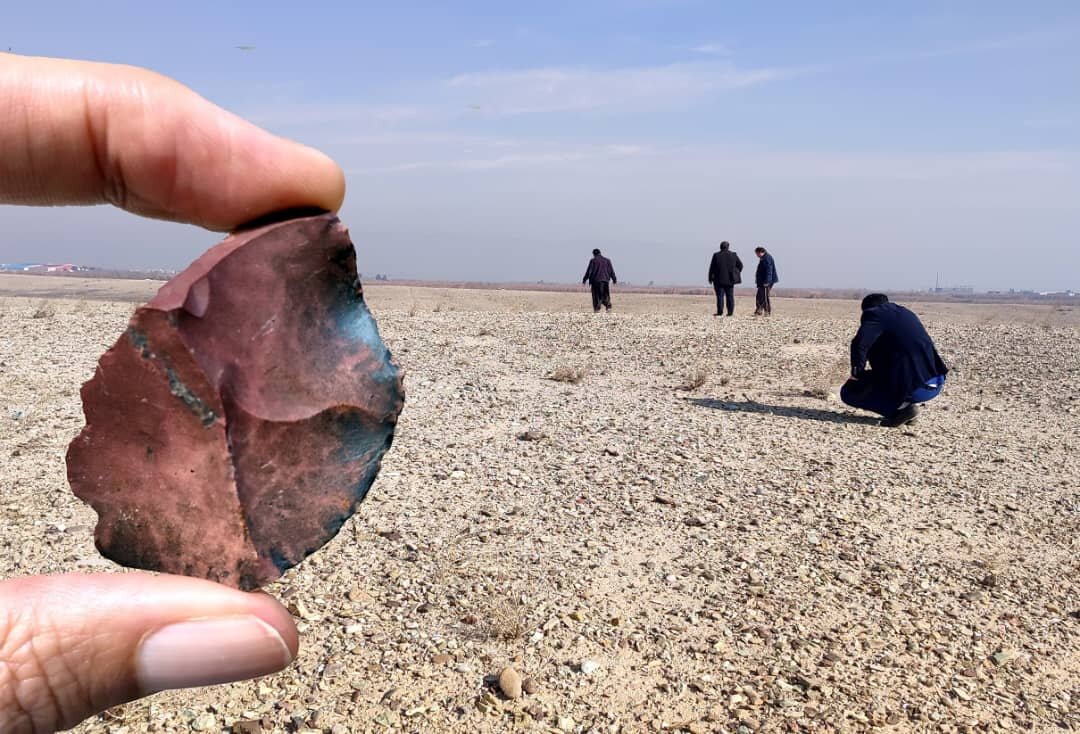Traces of early Paleolithic humans found near Tehran!

TEHRAN - The National Museum of Iran has revealed an exciting discovery in the south of Tehran - a collection of ancient stone tools dating back to the Paleolithic era.
The discovery was made in collaboration with researchers from the Research Institute of Cultural Heritage and Tourism (RICHT), the National Museum, and Tehran ICHTO.
Morteza Hessari, a member of RICHT's scientific staff, initially discovered several Paleolithic stone tools on a hillside near Qomiabad village. This led a team of researchers from the aforementioned institutions to revisit the area, where they uncovered a significant Paleolithic site.
According to Fereidoun Biglari, head of the Paleolithic Department of the National Museum of Iran, the discovery sheds new light on the Paleolithic occupation of the Tehran region.
Previously, only a few isolated finds of Paleolithic stone tools had been discovered in the area. However, the new site contains a large scatter of lithic artifacts that indicate it functioned as a workshop during the Middle Paleolithic Period.
The site's location, overlooking the surrounding plain, contains large quantities of stone raw materials such as flint, as well as other rock types, which attracted Middle Paleolithic tool makers to the area. The discovery suggests that humans have inhabited Tehran province for tens of thousands of years, potentially as far back as 40 to 80 thousand years ago.
The Neanderthal skeletal remains found in several caves in western Iran suggest that they may have been responsible for the stone tools discovered at the Qomiabad site during the Middle Paleolithic period.
Further research is planned to study this large site and gather more information about its function during the Middle Paleolithic Period.
Paleolithic Period
The Paleolithic Period is characterized by the use of rudimentary chipped stone tools. The popular Paleo diet, or Stone Age diet, is based on foods humans presumably would have consumed during the Paleolithic Period.
According to Britannica, the onset of the Paleolithic Period has traditionally coincided with the first evidence of tool construction and use by Homo some 2.58 million years ago, near the beginning of the Pleistocene Epoch (about 2.58 million to 11,700 years ago). In 2015, however, researchers excavating a dry riverbed near Kenya’s Lake Turkana discovered primitive stone tools embedded in rocks dating to 3.3 million years ago—the middle of the Pliocene Epoch (some 5.3 million to 2.58 million years ago). Those tools predate the oldest confirmed specimens of Homo by almost 1 million years, which raises the possibility that toolmaking originated with Australopithecus or its contemporaries and that the timing of the onset of this cultural stage should be reevaluated.
The Paleolithic Period is often divided into three parts: Lower, Middle, and Upper. However, anthropologists resist placing hard time boundaries on each subdivision and the stages within them, because technologies characteristic of different industries emerged at different times in different regions.
Paleolithic toolmaking
Different members of Australopithecus and Homo overlapped in time with one another for nearly one million years.
At sites dating from the Lower Paleolithic Period, simple pebble tools have been found in association with the remains of what may have been some of the earliest human ancestors. A somewhat more-sophisticated Lower Paleolithic tradition, known as the Chopper chopping tool industry, is widely distributed in the Eastern Hemisphere, and it is thought to have been the work of the hominin species named Homo erectus. It is believed that H. erectus probably made tools of wood and bone, although no such fossil tools have yet been found, as well as of stone.

About 700,000 years ago, a new Lower Paleolithic tool, the hand ax, appeared. The earliest European hand axes are assigned to the Abbevillian industry, which developed in northern France in the valley of the Somme River; a later, more refined hand-ax tradition is seen in the Acheulean industry, evidence of which has been found in Europe, Africa, the Middle East (West Asia), and Asia. Some of the earliest known hand axes were found at Olduvai Gorge (Tanzania) in association with remains of H. erectus. Alongside the hand-ax tradition, there developed a distinct and very different stone tool industry, based on flakes of stone: special tools were made from worked (carefully shaped) flakes of flint.
AM
